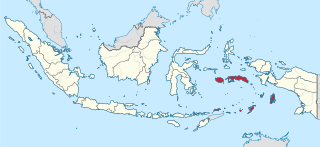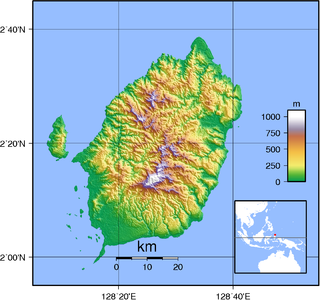
Ambon Island is part of the Maluku Islands of Indonesia. The island has an area of 743.37 km2 (287.02 sq mi) and is mountainous, well watered, and fertile. Ambon Island consists of two territories: the city of Ambon to the south and various districts (kecamatan) of the Central Maluku Regency to the north. The main city and seaport is Ambon, which is also the capital of Maluku province, while those districts of Maluku Tengah Regency situated on Ambon Island had a 2020 Census population of 128,069. Ambon has an airport and is home to the Pattimura University and Open University, state universities, and a few private universities, which include Darussalam University and Universitas Kristen Indonesia Maluku (UKIM).

HMAS Ipswich (J186/B244/A118), named for the city of Ipswich, Queensland, was one of 60 Bathurst-class corvettes built during World War II and one of 20 built on Admiralty order but manned by personnel of and later commissioned into the Royal Australian Navy (RAN).

Balikpapan is a seaport city in East Kalimantan, Indonesia. Located on the east coast of the island of Borneo, the city is the financial center of Kalimantan. Balikpapan is the city with the largest economy in Kalimantan with an estimated 2016 GDP at Rp 73.18 trillion. The city has the third busiest airport in Kalimantan after that in Banjarmasin and Pontianak, namely Sultan Aji Muhammad Sulaiman Sepinggan Airport. Port of Semayang was the second busiest seaport in East Kalimantan, after that in Samarinda.
Civil Air Transport (CAT) was a Nationalist Chinese airline, later owned by the U.S. Central Intelligence Agency (CIA), that supported United States covert operations throughout East and Southeast Asia. During the Cold War, missions consisted in assistance to "Free World" allies according to the Mutual Defense Assistance Act of 1949.

Maluku is a province of Indonesia. It comprises the central and southern regions of the Maluku Islands. The largest city and capital of Maluku province is Ambon on the small Ambon Island. It is directly adjacent to North Maluku, Southwest Papua, and West Papua in the north, Central Sulawesi, and Southeast Sulawesi in the west, Banda Sea, Australia, East Timor and East Nusa Tenggara in the south and Arafura Sea, Central Papua and South Papua in the east. The land area is 46,150.92 km2, and the total population of this province at the 2010 census was 1,533,506 people, rising to 1,848,923 at the 2020 census. The official estimate as at mid 2022 was 1,881,727. Maluku is located in Eastern Indonesia.

Permesta was a rebel movement in Indonesia that was declared on 2 March 1957 by civil and military leaders in East Indonesia. Initially the center of the movement was in Makassar, which at that time was the capital of the province of Sulawesi. However, support for the movement in South Sulawesi gradually dissipated, forcing the headquarters to move to Manado in North Sulawesi.

The Revolutionary Government of the Republic of Indonesia was a revolutionary government set up in Sumatra to oppose the central government of Indonesia in 1958.

HMS Aurochs (P426/S26), was an Amphion-class submarine of the Royal Navy, built by Vickers Armstrong and launched 28 July 1945. Her namesake was the aurochs, an extinct Eurasian wild ox ancestral to domestic cattle and often portrayed in cave art and heraldry.

Allen Lawrence Pope was an American military and paramilitary aviator. He rose to international attention as the subject of a diplomatic dispute between the United States and Indonesia after the B-26 Invader aircraft he was piloting in a Central Intelligence Agency (CIA) covert operation was shot down over Ambon on May 18, 1958, during the "Indonesian Crisis".

Alexander Evert Kawilarang was an Indonesian freedom fighter, military commander, and founder of Kesko TT, what would become the Indonesian special forces unit Kopassus. However, in 1958 he resigned his post as military attaché to the United States to join the separatist Permesta movement where he encountered Kopassus as his opponent. His involvement in Permesta damaged his military career, but he remained popular and active in the armed forces community.
HMS Heartsease was a Flower-class corvette of the Royal Navy. She served with both the Royal Navy and the United States Navy during the Second World War, with the latter navy as USS Courage. She then spent several years under a succession of names in civilian service. In 1957 she was chartered on behalf of Indonesian rebels to smuggle rubber, copra and matériel. The Indonesian Air Force intercepted and sank her off the coast of Minahasa in North Sulawesi in December 1958.

Morotai Island is an island in the Halmahera group of eastern Indonesia's Maluku Islands (Moluccas). It is one of Indonesia's northernmost islands.

Eagle Oil and Shipping Company was a United Kingdom merchant shipping company that operated oil tankers between the Gulf of Mexico and the UK. Weetman Pearson, 1st Viscount Cowdray founded it as the Eagle Oil Transport Company in 1912 and sold it to Royal Dutch Shell in 1919. It was renamed Eagle Oil and Shipping Company in about 1930, and remained a separate company within the Royal Dutch Shell group until it was absorbed in 1959.
William Henry Beale Jr. was a US military and paramilitary aviator. In the Second World War, he was in the USAAF and flew bombing missions in the northern Pacific theater. In the Permesta rebellion in Indonesia in 1958 he flew bombing missions for the CIA. His career ended on a CIA covert mission in Laos in 1962 when he was killed in a plane crash.
SS San Flaviano was a British oil tanker owned by Eagle Oil and Shipping Company, a British subsidiary of Royal Dutch Shell. She was built by Cammell Laird in England in 1956 and attacked and sunk by the CIA in Borneo in 1958.
MV Daronia was a 1930s British oil tanker owned by Anglo-Saxon Petroleum, a British subsidiary of Royal Dutch Shell. She was launched in 1938 by Hawthorn, Leslie in North East England and completed in 1939. She was one of a class of 20 similar tankers built for Anglo-Saxon.
SS Flying Lark was a ship built in Fredrikstad, Norway in 1915 as the banana boat SS Honduras. Over a 43 year career that spanned oceans and seas the world over she had 10 owners, eight names and a succession of different managers.
SS Armonia was a 2,740 GRT cargo ship built in Britain in 1924 for the Moor Line as SS Tullochmoor. Scrapped in 1960, she had eight sets of owners, managers and names over her 26-year career.












